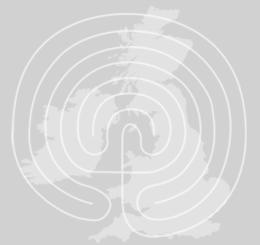Warblington Parsonage
The parsonage in Warblington was said to be haunted in the late 17th century. Though I do not believe the building to exist today, I understand it may have stood on Pook Lane. Below is how the story was published in 1897 in ‘The Haunted Homes and Family Traditions of Great Britain’ by John Ingram.
The following account of the hauntings at Warblington Parsonage, Hampshire, furnishes particulars of a story often referred to by writers on the supernatural, but which, apparently, they have never read, and only speak of by repute. The original version, as now repeated, was given in a letter written by Caswell, the mathematician, to the learned Dr. Bentley, whilst the latter was living at the house of Stillingfleet, the celebrated Bishop of Worcester. The name of the deceased person who was supposed to have appeared was suppressed at the time, for obvious reasons, but it has since been discovered to have been the Rev. Sebastian Pitfield, who was incumbent in 1677. An extract from Caswell’s letter to Bentley will serve to introduce the narrative itself; he writes:
“I have sent you enclosed a relation of an apparition. The story I had from two persons, who each had it from the author, and yet their accounts somewhat varied, and passing through more mouths has varied much more; therefore I got a friend to hring me the author, at a chamber, where I wrote it down from the author’s mouth, and which, when I read it to him, and gave him another copy, he said he could swear to the truth of it as far as he was concerned. He is the curate of Warblington, Bachelor of Arts in Trinity College, Oxford, about six years standing in the University. I hear no ill report of his behaviour here. He is now gone to his curacy. He has promised to send up the hands of the tenant and his man, and the farmer’s men, as far as they are concerned. Mr. Brereton, the rector, would have him say nothing of the story, for that he can get no tenant, though he has offered the house for ten pounds a year less. Mr. P., the former incumbent, whom the apparition represented, was a man of a very ill report, supposed to have got children of his maid, and to have murdered them; but I advised the curate to say nothing himself of this last part of P., but to leave that to the parishioners who knew him.”
The narrative enclosed by Caswell, of the apparition, as written out by the curate, the Rev. Thomas Wilkins, on the 15th of December 1695, is as follows :
“At Warblington, near Havant, Hampshire, within six miles of Portsmouth, in the parsonage-house, dwelt Thomas Perce, the tenant, with his wife and child, a man-servant Thomas, and a maid-servant. About the beginning of August 1695, on a Monday, about nine or ten at night, all being gone to bed except the maid with the child, she being in the kitchen, and having raked up the fire, took a candle in one hand, and the child in the other arm, and turning about, saw someone in a black gown walking through the room, and thence out of the door into the orchard. Upon this the maid, hasting up-stairs, having recovered but two steps, cried out ; on which the master and mistress van down, found the candle in her hand, she grasping the child about its neck with the other arm. She told them the reason of her crying out ; she would not that night tarry in the house, but removed to another belonging to one Henry Salter, farmer, where she cried out all the night from the terror she was in, and she could not be persuaded to go to the house upon any terms.
“On the morrow, Tuesday, the tenant’s wife came to me, lodging then at Havant, to desire my advice, and have consultation with some friends about it. I told her I thought it was a flam, and that they had a mind to abuse Mr. Brereton, the rector, whose house it was. She desired me to come up. T told her T would oomo up and sit up, or lie there, as she pleased ; for then, as to all stories of ghosts, or apparitions, I was an infidel. I went thither and sat up the Tuesday night with the tenant and his man-servant. About twelve or one o’clock I searched all the rooms in the house, to see if anybodv were hid there to impose upon me. At last we came, into a lumberoom; there I smiling told the tenant that was with me, that I would call for the apparition, if there was any, and oblige him to come. The tenant then seemed to be afraid, but I told him I would defend him from harm, and then I repeated Barbara celarent Darii, &c. jestingly ; on this the tenant’s, countenance changed, so that he was ready to drop down with fear. Then I told him I perceived he was afraid, and I would prevent its coming, and repeated Baralipton, &c, and then he recovered his spirits pretty well, and we left the room and went down into the kitchen, where we were before, and sate up there the remaining part of the night, and had no manner of disturbance.
“Thursday night the tenant and I lay together in one room, and he saw something walk along in a black gown and place itself against a window, and there stood for some time, and then walked off. Friday morning, the man relating this, I asked him why he did not call me, and I told him I thought that it was a trick or flam ; he told me the reason why he did not call me was that he was not able to speak or move. Friday night we lay as before, and Saturday night, and had no disturbance either of the nights.
“Sunday I lay by myself in one room (not that where the man saw the apparition), and the tenant, and his man in one bed in another room, and betwixt twelve and two the man heard something walk in their room at the bed’s foot, and whistling very well, and at last it came to the bed’s bide, drew the curtain, ami looked on them. After some time it moved off; tLicn Lho man called to me, desired me to come, for that there was something in the room went about whistling. I asked him whether he had any light, or could strike one ; he told me no. Then I leapt out of bed, and not staying to put on my clothes, went out of my room, and along a gallery to the door, which I found locked or bolted. I desired him to unlock the door, for that I could not get in ; then he got out of bed and opened the door, which was near, and went immediately to bed again. I went in three or four steps, and it being a moonlight light, I saw the apparition move from the bedside, and stop up against the wall that divided their room and mine. I went and stood directly against it, within my arm’s length of it, and asked it, in the name of God, what it was that made it come disturbing of us? I stood some time expecting an answer and receiving none, and thinking it might be some fellow hid in the room to fright me, I put out my arm to feel it, and my ha?id seemingly icent through the body of it, and felt no manner of substance till it came to the wall; then I drew back my hand, and still it was in the same place.
“Till now,” declares Mr. Wilkins, “I had not the least fear, and even now had very little ; then I adjured it to tell me what it was. When I had said those words it, keeping its back against the wall, moved gently along towards the door. I followed it, and it, going out at the door, turned its back towards me. It went a little along the gallery, I followed it a little into the gallery, and it disappeared, where there was no corner for it to turn, and before it came to the end of the gallery, where were the stairs. Then I found myself very cold from my feet as high as my middle, though I was not in great fear. I went iuto the bed betwixt the tenant and his man, and they complained of my being exceedingly cold. The tenant’s man leaned over his master in the bed, and saw me stretch out my hand towards the apparition, and heard me speak the words ; the tenant also heard the words. The apparition seemed to have a morning gown of a darkish colour, no hat nor cap, short black hair, a thin, meagre visage of a pale swarthy colour, seemed to be of about forty-five or fifty years old, the eyes half shut, the arms hanging down, the hands visible beneath the sleeves, of a middle stature. I related this description to Mr. John Lardner, rector of Havant, and to Major Battin of Langstone, in Havant parish ; they both said the description agreed very well to Mr. P(itfield), a former rector of the place, who has been dead above twenty years. Upon this the tenant and his wife left the house, which has remained void since.
“The Monday after last Michaelmas,” resumes Mr. Wilkins, “a man of Chodson, in Warwickshire, having been at Havant fair, passed by the foresaid parsonage house about nine or ten at night, and saw a light in most of the rooms of the house. His pathway being close by the house, he, wondering at the light, looked into the kitchen window, and saw only a light ; but turning himself to go away, he saw the appearance of a man in a long gown. He made haste away; the apparition followed him over a piece of glebe-land of several acres to a lane, which he crossed, and over a little meadow, and then over another lane to some pales which belong to farmer Henry Salter, my landlord, near a barn, in which were some of the farmer’s men and some others. This man went into the barn, told them how he was frighted and followed from the parsonage house by an apparition, which they might see standing against the pales if they went out. They went out, and saw it scratch against the pales, and make a hideous noise. It stood there some time, and then disappeared. Their description agreed with what I saw. This last account I had from the man himself whom it followed, and also from the farmer’s men.”
In conclusion may be appended to this very circumstantial document of the Rev. Thomas Wilkins, the statement that it was subsequently alleged that the Rev. Sebastian Pitfield, whom the apparition was presumed to personify, had murdered his own illegitimate children.




Re: Warblington Parsonage
The British Magazine and Monthly Register of Religious and Ecclesiastical Information, Parochial History, and Documents Respecting the State of the Poor, Progress of Education, Etc, Volume 4 (1833)
Sebastian Pitfield held the living of Warblington in the year 1677. Connected with him is a tale told in Cumberland’s periodical work the Observer no.71 which deserves notice. The paper in question contains a letter from Mr Caswell the mathematician, to the Rev Dr Richard Bentley dated Dec 15 1695, inclosing a narrative by Mr Thomas Wilkins curate of Warblington, giving an account of some mysterious appearances in and about the parsonage. The outline of the story is that the then rector Mr Brereton, being rector also of the neighbouring parish of Westbourne, resided in this latter parish and let his house at Warblington, that the tenant and his servants were at various times disturbed and terrified by the appearance of a person in a long black gown walking about the house and premises scratching and whistling, that Mr Wilkins being called in to lay the ghost for what else could it be, saw it himself and putting out his arm to feel it his hand seemingly went through the body of it and felt no manner of substance, after which it vanished at the end of a gallery where there was no stairs. Appended to this is an observation that Mr P, a former rector used to wear a black gown and used to whistle, that he was a man of very ill report supposed to have got children of his maid and to have murdered them to which Cumberland, in a note gravely adds, I make no remark upon this genuine account except as to the passage which I have put in italics. If Mr Wilkins was thoroughly possessed of himself at that moment as he deposes and is strictly correct, in this fact the narrative is established. Now with all due deference to Mr Cumberland, the evidence is surely insufficient on which so decided an opinion is pronounced. That the tenant and his servants would be liable to be infected by the superstition of that period will not be denied, from which the curate can scarcely be said to be exempted, when he could be brought to believe that an inhabitant of the other world would appear in this for the purpose of scratching and whistling Risum teneatis. Surely such testimony as this should not be permitted to blacken the character of an individual in Mr Pitfield’s situation, for from the date &c he must be the Mr P alluded to. As far as we have the means of knowing he was a respectable man and attentive to his duty. By his signature in the vestry book we find that he presided regularly at the vestry meetings of his parish, it is but common charity therefore to hope that he was equally diligent in the discharge of his other duties and least of all should he without some better authority be stigmatized as a libertine and a murderer. A clue however to the ghost story may be found in the following circumstances. The rector Mr Brereton was as has before been stated non resident. For some time the house was left in the care of servants. These servants connected themselves with smugglers with which the whole southern coast of Hampshire and Sussex was at that period much infested. They allowed tliem to use the rectory house as a place of resort for their illicit purposes as a proof of which during some repair of the pre mises above forty years since a large cellar or cave was discovered which had evidently been used as a store for smuggled spirits. At length the rector determined on letting the house which it was an object with the smugglers to prevent. A magic lantern a little trickery and a great deal of superstition will explain the rest. It will not however perhaps be quite so readily credited that a strong impression prevailed among some of the country people about ten years ago that the ghost which they said had been laid for a hundred years was going to re appear. But to use Dr Johnson’s expression “nothing came of it”.